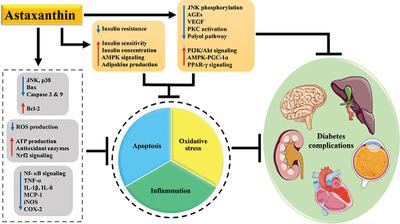当前位置:
X-MOL 学术
›
Mol. Nutr. Food Res.
›
论文详情
Our official English website, www.x-mol.net, welcomes your feedback! (Note: you will need to create a separate account there.)
Multi-Mechanistic Antidiabetic Potential of Astaxanthin: An Update on Preclinical and Clinical Evidence
Molecular Nutrition & Food Research ( IF 5.2 ) Pub Date : 2021-10-12 , DOI: 10.1002/mnfr.202100252 Vemana Gowd 1, 2 , Jianbo Xiao 3, 4 , Mingfu Wang 1, 5 , Feng Chen 1, 6 , Ka-Wing Cheng 1, 6
Molecular Nutrition & Food Research ( IF 5.2 ) Pub Date : 2021-10-12 , DOI: 10.1002/mnfr.202100252 Vemana Gowd 1, 2 , Jianbo Xiao 3, 4 , Mingfu Wang 1, 5 , Feng Chen 1, 6 , Ka-Wing Cheng 1, 6
Affiliation

|
Diabetes mellitus (DM) is a cluster of physiological dysfunctions typified by persistent hyperglycemia. Diet plays a paramount role in human health, and regular consumption of a fruit- and vegetable-rich diet can delay or prevent DM and its associated complications. The promising effect of fruits and vegetables could be partly attributed to their antioxidant constituents, including carotenoids. Carotenoids are natural antioxidants that occur in many vegetables, fruits, microalgae, and other natural sources. Astaxanthin is a xanthophyll carotenoid predominantly present in microalgae and some red-colored marine organisms. It is currently marketed as a health supplement and is well-known for its antioxidant capacity. Accumulating evidence indicates that astaxanthin exerts its beneficial effects against DM by acting on various molecular targets and signaling pathways in multiple organs/tissues. Astaxanthin can lower blood glucose levels by preserving β-cell function, improving insulin resistance (IR), and increasing insulin secretion. This manuscript summarizes the connection between glucose homeostasis, oxidative stress, and DM. This is followed by a review of recent studies on astaxanthin's pharmacological effects against IR, microvascular (diabetic retinopathy, diabetic nephropathy, and neurological damage), and macrovascular DM complications emphasizing the cellular and molecular mechanisms involved. A few lines of clinical evidence supporting its antidiabetic potential are also highlighted.
中文翻译:

虾青素的多机制抗糖尿病潜力:临床前和临床证据的更新
糖尿病 (DM) 是一组以持续性高血糖为代表的生理功能障碍。饮食在人类健康中起着至关重要的作用,经常食用富含水果和蔬菜的饮食可以延缓或预防 DM 及其相关并发症。水果和蔬菜的良好效果部分归因于它们的抗氧化成分,包括类胡萝卜素。类胡萝卜素是存在于许多蔬菜、水果、微藻和其他天然来源中的天然抗氧化剂。虾青素是一种叶黄素类胡萝卜素,主要存在于微藻和一些红色海洋生物中。它目前作为保健品销售,并以其抗氧化能力而闻名。越来越多的证据表明,虾青素通过作用于多个器官/组织中的各种分子靶点和信号通路发挥其对 DM 的有益作用。虾青素可以通过保护 β 细胞功能、改善胰岛素抵抗 (IR) 和增加胰岛素分泌来降低血糖水平。这份手稿总结了葡萄糖稳态、氧化应激和 DM 之间的联系。随后回顾了最近关于虾青素对 IR、微血管(糖尿病视网膜病变、糖尿病肾病和神经损伤)和大血管 DM 并发症的药理作用的研究,强调了所涉及的细胞和分子机制。还强调了一些支持其抗糖尿病潜力的临床证据。虾青素可以通过保护 β 细胞功能、改善胰岛素抵抗 (IR) 和增加胰岛素分泌来降低血糖水平。这份手稿总结了葡萄糖稳态、氧化应激和 DM 之间的联系。随后回顾了最近关于虾青素对 IR、微血管(糖尿病视网膜病变、糖尿病肾病和神经损伤)和大血管 DM 并发症的药理作用的研究,强调了所涉及的细胞和分子机制。还强调了一些支持其抗糖尿病潜力的临床证据。虾青素可以通过保护 β 细胞功能、改善胰岛素抵抗 (IR) 和增加胰岛素分泌来降低血糖水平。这份手稿总结了葡萄糖稳态、氧化应激和 DM 之间的联系。随后回顾了最近关于虾青素对 IR、微血管(糖尿病视网膜病变、糖尿病肾病和神经损伤)和大血管 DM 并发症的药理作用的研究,强调了所涉及的细胞和分子机制。还强调了一些支持其抗糖尿病潜力的临床证据。随后回顾了最近关于虾青素对 IR、微血管(糖尿病视网膜病变、糖尿病肾病和神经损伤)和大血管 DM 并发症的药理作用的研究,强调了所涉及的细胞和分子机制。还强调了一些支持其抗糖尿病潜力的临床证据。随后回顾了最近关于虾青素对 IR、微血管(糖尿病视网膜病变、糖尿病肾病和神经损伤)和大血管 DM 并发症的药理作用的研究,强调了所涉及的细胞和分子机制。还强调了一些支持其抗糖尿病潜力的临床证据。
更新日期:2021-12-15
中文翻译:

虾青素的多机制抗糖尿病潜力:临床前和临床证据的更新
糖尿病 (DM) 是一组以持续性高血糖为代表的生理功能障碍。饮食在人类健康中起着至关重要的作用,经常食用富含水果和蔬菜的饮食可以延缓或预防 DM 及其相关并发症。水果和蔬菜的良好效果部分归因于它们的抗氧化成分,包括类胡萝卜素。类胡萝卜素是存在于许多蔬菜、水果、微藻和其他天然来源中的天然抗氧化剂。虾青素是一种叶黄素类胡萝卜素,主要存在于微藻和一些红色海洋生物中。它目前作为保健品销售,并以其抗氧化能力而闻名。越来越多的证据表明,虾青素通过作用于多个器官/组织中的各种分子靶点和信号通路发挥其对 DM 的有益作用。虾青素可以通过保护 β 细胞功能、改善胰岛素抵抗 (IR) 和增加胰岛素分泌来降低血糖水平。这份手稿总结了葡萄糖稳态、氧化应激和 DM 之间的联系。随后回顾了最近关于虾青素对 IR、微血管(糖尿病视网膜病变、糖尿病肾病和神经损伤)和大血管 DM 并发症的药理作用的研究,强调了所涉及的细胞和分子机制。还强调了一些支持其抗糖尿病潜力的临床证据。虾青素可以通过保护 β 细胞功能、改善胰岛素抵抗 (IR) 和增加胰岛素分泌来降低血糖水平。这份手稿总结了葡萄糖稳态、氧化应激和 DM 之间的联系。随后回顾了最近关于虾青素对 IR、微血管(糖尿病视网膜病变、糖尿病肾病和神经损伤)和大血管 DM 并发症的药理作用的研究,强调了所涉及的细胞和分子机制。还强调了一些支持其抗糖尿病潜力的临床证据。虾青素可以通过保护 β 细胞功能、改善胰岛素抵抗 (IR) 和增加胰岛素分泌来降低血糖水平。这份手稿总结了葡萄糖稳态、氧化应激和 DM 之间的联系。随后回顾了最近关于虾青素对 IR、微血管(糖尿病视网膜病变、糖尿病肾病和神经损伤)和大血管 DM 并发症的药理作用的研究,强调了所涉及的细胞和分子机制。还强调了一些支持其抗糖尿病潜力的临床证据。随后回顾了最近关于虾青素对 IR、微血管(糖尿病视网膜病变、糖尿病肾病和神经损伤)和大血管 DM 并发症的药理作用的研究,强调了所涉及的细胞和分子机制。还强调了一些支持其抗糖尿病潜力的临床证据。随后回顾了最近关于虾青素对 IR、微血管(糖尿病视网膜病变、糖尿病肾病和神经损伤)和大血管 DM 并发症的药理作用的研究,强调了所涉及的细胞和分子机制。还强调了一些支持其抗糖尿病潜力的临床证据。



























 京公网安备 11010802027423号
京公网安备 11010802027423号